|
SUBSIM Book Reviews - Naval and submarine books

|
|
|

Ships for All Nations
Author:
Ian Johnston
This revised edition forms
part of a trilogy of books on the former Clydebank shipyard of John
Brown & Co. Taking advantage of the massive number of original
photographs and internal documents preserved by the Scottish
National Archives, this book presents an in-depth history of the
yard's life. From the formation of J&G Thomson in 1847, to the
opening of the Clydebank yard in 1871, acquisition by John Brown &
Co in 1899, the triumphs of the 20th century, to the yard's demise
in 1972, this book is epic in scope.
|
|
 RN
Submarine Owner's Workshop Manual
RN
Submarine Owner's Workshop Manual
Author: Peter Goodwin
Peter
Goodwin is a former Royal Navy submariner and acclaimed naval
historian, and having written a Haynes manual on the HMS Victory
in 2012, delivers the goods this time around. This book feels
like a genuine apology to this submarine geek and Haynes fanboy.
Although it contains brief sections covering the development of
Britain's submarine fleet, Alliance's operational history,
and what it was like to live and work aboard, the bulk of this book
is a straight-up technical reference. |
|
 Clydebank
Battlecruisers & A Shipyard at War
Clydebank
Battlecruisers & A Shipyard at War
Author: Ian Johnston
What makes the book invaluable for modelers and fans of early 20th
century warships is the extremely high quality of the photographs.
Plate glass photography required long exposures, but the results
were frequently stunning. While some are a little overexposed or out
of focus, the majority of the photos are extremely crisp and fine
grained, frequently atmospheric, and often loaded with detail.
|
|
 The Trident
Deception
The Trident
Deception
Author:
Rick
Campbell
An American Trident missile sub--USS
Kentucky-- receives a launch order. They are about eight days away
from being in range, the countdown begins. US fast attacks
are sent with orders to kill, if they can find the Kentucky. The Pacific
fleet is mobilized, even an Australian sub is tasked with
intercepting and stopping the US sub from committing nuclear
genocide. |
|
 British
Cruisers of the Victorian Era
British
Cruisers of the Victorian Era
Author:
Norman Friedman
Norman Friedman, you have this amazing knack of hunting down obscure
bits of information and incorporating it into your books. You make the
frustrating and arcane process of ship design and naval architecture
seem really interesting. You make me care about naval tactics, the
politics of national defense, block coefficients, and low-angle fire
control. You somehow have this amazing ability to combine all this
stuff into a single cohesive naval history book. |
|
 The
Hidden Threat The
Hidden Threat
Author: Jim Crossley
The battleship Audacious became
an early victim in what would now be a large and visible change of the
sea with the use of sea mines. Initially feared that she had been hit by
a torpedo, but it was not a submarine which had caused damage to
Audacious , it was the Berlin (liner, 17.000 tons), a fast,
armed merchant cruiser with 200 deadly mines.
|
|
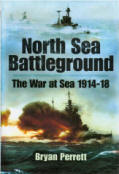 North
Sea Battleground North
Sea Battleground
Author: Bryan Perret
During WW1 the North Sea became the principal battleground for the
navies of Britain and Germany. This book explains in chronological
order the major encounters between Kaiser Wilhelm II's High Seas Fleet
and the Royal Navy. It also includes other important operations such
as mine-laying and sweeping, the Zeppelin Offensive, the bomber
offensive against the UK and complete background operational
information within the area. |
|
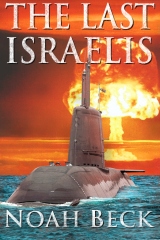 The
Last Israelis The
Last Israelis
Author: Noah Beck
Threats of annihilation
directed toward Israel that routinely come from Syria and Iran have
not gone away, and Israel takes them seriously. With Iran actively
seeking to add nukes as part of its military, the situation draws
closer to conflict. In Noah Beck's The Last Israelis, the setting could be lifted from Fox News: Iran has acquired nukes and has leaders who
are twitching to use them. Israel has leadership problems and may
not be prepared for the coming crisis.
The international community and its usual indifference becomes a
hindrance.
Though
it all, one Israeli submarine is scrambled to deliver ten rather small
nuclear cruise missiles if everything goes to hell.
|
|
 Evolution
of the Wooden Ship Evolution
of the Wooden Ship
Author: Basil Greenhill
Most books on wooden ship construction
focus on big, grand vessels, Clippers and Ships of the Line being the
most popular choices. The second, and largest, part of this book takes
the interesting choice of depicting the construction of a small, fairly
simple merchant ship. The ship in question is a fictional two-masted
schooner known as Master's Schooner, built on the River Tamar in South
Devon, England, in the late 1880s. Ships of this type were built by the
hundreds, supplying English coastal towns with much-needed coal and
timber.
|
|
 War
in the Boats: My WWII Submarine Battles War
in the Boats: My WWII Submarine Battles
Author: William J. Ruhe, USN
(Ret.)
The Crevalle came under attack by
Japanese ASW ships and two days later they are sitting around making
repairs or playing cards. They sat on the bottom to break contact with
Japanese ASW. The attacking Japanese dragged grappling hooks along
the bottom to try and hook the Crevalle. Ruhe and his fellow
officers tried to find out what that clanking noise was when suddenly
they were hooked like a fish. |
|
 Sea
Warfare in the North Atlantic Sea
Warfare in the North Atlantic
Author: Peter Dornan
The film takes us through both the
realm of the mighty English and German battleships and cruisers.
Particularly striking are the changing images of the people, who fought
for those two countries in the conflict that would last until 1945.
The film mixed with realism and German propaganda films, in constructing
the submarine fleet, and takes the viewer close to the battlefield. |
|
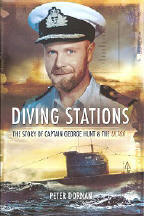 Diving
Stations Diving
Stations
Author: Peter Dornan
Proteus and an
Italian destroyer surprised each other with a close encounter in a dark,
stormy night. While Captain Phillip Francis on the bridge was calling
frantic maneuvering commands down the voice tube to the
helmsmen, Hunt called up to remind the captain they were still
running on batteries, not the diesels. Captain Francis "called back down
the pipe, "You wouldn't be worried about the bloody batteries if you
were up here!". The sub and destroyer mutually rammed each other,
and the sub's bow plane served as a dagger to the escort's side. |
|
 Midget
Submarine Commander Midget
Submarine Commander
Author: Paul Watkins
RN officer Godfrey Place was trained up
to navigate one of the diminutive British X-craft through anti-sub and
torpedo nets in a Norwegian harbor to plant charges under the massive
German battleship Tirpitz. The task, dubbed Operation Source, was
exceedingly dangerous: not only were the German defenses formidable, but
the midget subs themselves were fragile and untrustworthy craft. "If one
thing goes wrong, everything goes wrong," Place stated. |
|
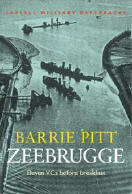 Zeebrugge:
Eleven VC’s Before Breakfast Zeebrugge:
Eleven VC’s Before Breakfast
Author: Barrie Pitt
This book tells a quite slanted view of
what was actually a daring series of raids attempting to block the
Belgian harbour entrance in
1918. The story itself is fascinating with many characters and heroes
with the subtitle of the book proclaiming the amazing statistic of
eleven VC’s being won before breakfast, not to mention the 21 DSO’s and
29 DSC’s awarded for the action.
|
|
 Private
Beatson's War Private
Beatson's War
Authors: James Beatson, Shaun Springer, Stuart Humphreys
"Today the sun is bright but
cold still. Dredgers, minesweepers (this line means that I got a
blow from a block which some fool upset which about finished this
diary and me) and small craft churn up and down. Hospital ships are
anchored here and there. Last night as we sailed past them a low
cheer was raised on both sides, low because strict orders were given
for silence. A seaplane has whirred overhead once or twice,
searching like a hawk for some submarine rat." |
|
 U-Boat
War U-Boat
War
Author: Lothar-Günther Buchheim
Lothar-Günther Buchheim, an artist
before the war, enlisted in the Kriegsmarine in 1940. As a war
correspondent, he wrote about his experiences onboard minesweepers and
destroyers for the propaganda magazine Signal. In the Autumn of 1941, he
joined the crew of U-96 for a single patrol. Armed with a camera and
dozens of rolls of film, he sought out to record the U-boat experience
in exhausting detail. As he states in the introduction "every aspect,
every detail, counted, bore witness to the reality of war, for unless I
captured it on film it was irretrievably gone."
|
|
 Battle
At Sea Battle
At Sea
Author:
Reg Grant
Battle At Sea begins with a short history of
the evolution of fighting ships, accompanied by a useful glossary. The
book is divided into four sections: The Age of Galleys 1200 BCE - 1550
ACE, Guns, Sail, and Empire 1550-1850, Steam and Steel 1830-1918, and
Carriers, Submarines, and Missiles 1918-Present. Each of these chapters
opens with a brief introduction to the naval developments of that
period, along with an illustrated timeline. These chapters are further
divided by broader subject (for example, "Rivalry Across the North
Sea"), and finally by individual conflicts. |
|
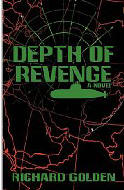 Depth
of Revenge Depth
of Revenge
Author: Richard Golden
Captain Gilad has troubles of his own. His diesel-electric
sub requires fuel, and is the subject of an intense search by enemies
and friends alike. His crew react to the news that their loved ones and
homeland have been hit with shock, rage, and depression. They are aware
something has happened, that nukes have been used against them, and the
uncertainty is such that their reactions vary, and Gilad struggles to
retain order on his boat. Gilad opens the sealed orders that lay out in
surprising detail, all the steps and elements that must be taken in
consideration. Armageddon has been thrust upon the Holy Land.
|
|
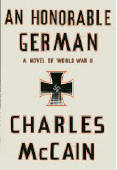 An
Honorable German An
Honorable German
Author: Charles McCain
Oberleutnant Max Breckendorf is the
First Officer aboard the Graf
Spee. The Kriegsmarine is finding success against the Royal
Navy, raiding merchant ships with pocket battleships and a growing
U-boat fleet. Max, and his life-long friend, the engineering officer
Dieter, are men of duty and discipline. Max holds a formidable store of
contempt for the British and gives little thought to the basis for the
war. His focus is on his career and his tasks. Max and Dieter
command boarding parties that round up the crews. The Prizes Rules are
closely followed; Germany's grim future is yet to appear. |
|
  Endgame:
The U-boat Inshore Campaign Endgame:
The U-boat Inshore Campaign
Author: Dr. John White
One of the strengths of Endgame
is the source material. Dr. White explains that most war diaries from
U-boats were intentionally destroyed as the end of the war drew close.
White turned to decrypted wireless messages and uncovered new U-boat war
diaries in his quest to chronicle the Inshore Campaign in greater detail
than before. He lays in a solid background on the state of the U-boat
arm and its weapons as the campaign unfolds. The book progresses from
there to a series of individual accounts by U-boats. Each episode frames
the situation the U-boat commanders faced as the odds against them grew
to staggering proportions. |
|
 Midway:
The Battle That Doomed Japan Midway:
The Battle That Doomed Japan
Author: Mitsuo Fuchida, Masatake Okumiya
Although the winner "always writes
history," when one considers most naval battles that old maxim falls
flat on it's face. Attempting to write a balanced account of the
Japanese side of the Battle of Midway from a purely American perspective
would be simply impossible. Dive bomber pilots boring down on their
targets at 250 knots were often unreliable witnesses, nor were they
aware of what their opponents were thinking at the moment. Mitsuo
Fuchida was the first Japanese participant of the battle to have a book
published in the West depicting Midway from his nation's perspective. |
|
 The
U-boat: The Evolution and Technical History of German Submarines The
U-boat: The Evolution and Technical History of German Submarines
Author: Eberhard Rossler
Rossler is at his best when discussing
the more obscure or highly technical aspects of U-boat design and
construction. The sections devoted to single-drive U-boats and the Type
XXI and XXIII "Elektroboots" are substantial enough to be separate books
in their own right, along with the numerous Walter designs. Rossler's
treatment of the Type XXI explores in great detail the boat's evolution,
the sectional construction process, the impact of Allied air raids, the
results of initial testing, and the numerous deficiencies of the final
design. There are also sections devoted to the evolution of sonar,
torpedoes, anti-aircraft armament, and midget submersibles, along with
U-boat construction processes and proposed bombproof construction
shelters.
|
|
 Das
Boot Das
Boot
Author: Lothar-Günther Buchheim
Das Boot
is noted for its relentlessly vivid and
realistic depiction of what it's like to be locked away in a stinky
metal tube for weeks on end, with a good chance of being suddenly
drowned. Das Boot is certainly the roughest, most grueling, and
most claustrophobic submarine novel ever written. Not much is actually
left to the reader's imagination; you can almost smell the horrid stench
rising up from the bilge, feel the condensation running down the
bulkheads, and grow numb from the endless hammering of the diesels.
|
|
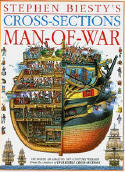 Incredible
Cross Sections:
Man-Of-War Incredible
Cross Sections:
Man-Of-War
Author:
Richard Platt (Illustrated by Stephen Biesty)
The subject of this book is a British
100-gun first-rate ship-of-the-line of the late 18th Century, a virtual
replica in all but name of Horatio Nelson’s famous HMS Victory.
The author slices the ship into 10 vertical sections from fore to aft,
each slice depicting a different aspect of life onboard, including
health and medicine, sleeping, resupplying in port, battle, and working
at sea. Each spread includes a large transverse section through the ship
with important features labeled and described, and summaries covering
subjects ranging from how cannons were fired, the tools used by the
surgeon, and what the crew ate. |
|
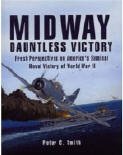 Midway:
Dauntless Victory Midway:
Dauntless Victory
Author: Peter C. Smith
Dauntless Victory is very much a
“grognard” book, packed with seemingly obscure details whose inclusion
in the main text often isn’t immediately obvious until later in the
book. It’s packed with interviews with surviving principals, tables,
flight crew rosters, discussions of naval tactics and equipment, and
mini-biographies of every major player. Uniquely, Dauntless Victory
is written by a British historian, rather than Japanese or American
writer like most books on the subject.
|
|
 Cold
War Submarines Cold
War Submarines
Authors:
Norman Polmar and Kenneth Moore
Between August 1945 and December 1991,
the United States and Soviet Union built 936 submarines, 401 of which
were nuclear powered. Of this total, the Soviets built more than 650,
building at least 50 identifiable classes in all. In Western
intelligence reports, speculation prevailed regarding the true
capabilities of Russia's underwater warships. Since the early 90's,
submarine buffs have eagerly awaited a definitive book on the design and
construction of submarines during the Cold War.
|
|
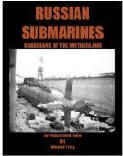 Russian
Submarines: An Illustrated View Russian
Submarines: An Illustrated View
Author:
Wayne Frey
If a naval enthusiast wishes to study
pictures of Russian subs, he simply does a
Google image search. You've seen the stock images that litter the
web but nothing like that will prepare you for the motherload of
detailed and highly sensitive images contained in Wayne Frey's
Russian Submarines. This 125-page book is filled with close-ups of
Akulas, Alfas, and Typhoons, at sea, under construction, and from
unique--and previously classified--angles. This book would have
created an international stir just a decade past. |
|
 Anatomy
of the Ship Heavy Cruiser Takao Anatomy
of the Ship Heavy Cruiser Takao
Author: Janusz Skulski
Takao had a long, rather interesting career. Having
participated in almost every major campaign of the Second World War,
Takao was almost sunk by two torpedoes fired from the submarine
Darter during the Battle of Leyte Gulf. Towed to Singapore, she
was deemed too heavily damaged to be repaired, and spent the rest of
the war as a floating anti-aircraft battery.
After the war, the Allied occupation forces used Takao as a
communication, repair, and accommodation base, eventually scuttling
the ship in the Malacca Straight on October 27, 1946. |
|
 Tales
from a Tin Can Tales
from a Tin Can
Author: Michael Keith Olsen
In March, 1943, while patrolling off the
coast of Kamchatka Peninsula, a task force consisting of two US
cruisers and Dale ambushed what they thought were three Japanese
transports. The battle quickly took a deadly turn for Dale--the
transports were escorted by faster and more powerfully armed Japanese
heavy cruisers, in attendance with two IJN light cruisers and four
destroyers, kicking off a terrifying two-day naval engagement.
|
|
 Scorpion
Down Scorpion
Down
Author: Ed Offley
No one has ever been able to determine what happened to the Scorpion.
Had one of the torpedoes "gone hot" and exploded while still inside it's
tube? Could the Trash Disposal Unit have failed? Did the diving planes
jam themselves in full down position, sending the submarine into an out
of control dive? A small percentage believed that foul play on the part
of Soviet Navy had caused the destruction of the Scorpion. Most
of these theories have been pretty thoroughly debunked, but that didn't
stop Ed Offley from writing Scorpion Down.
|
|
 War
at Sea War
at Sea
Author: Ronald H. Spector
The evolution of naval warfare in a
nutshell? In the Napoleonic era, two opposing fleets might have five
hours to plan a battle strategy. By World War I, that time had dropped
to as little as five minutes. In the era of radar, guided missiles,
and sophisticated electronic countermeasures, a commander might have
five seconds to react to an incoming missile or torpedo. Surely, the
unstoppable march of technological advancement can't be the only
reason for these breathtaking advances. What about the men
behind the machines?
|
|
 Sea
of Thunder Sea
of Thunder
Author: Evan Thomas
Halsey was the naval hero that America needed in it's time of crisis.
Flaunted by the press as the second coming of Admiral Nelson, Halsey
was a chain smoking, no-nonsense kind of guy who refused to eat off of
fine China because it was "made in Japan." Halsey's luster began to
wear off as his obsession with sinking the Japanese carriers nearly
resulted in the destruction of much of the 7th fleet, left behind to
guard the San Bernadino Straight between Layte and Samar.
|
|
 The
Naval Institute Guide to World Naval Weapon Systems The
Naval Institute Guide to World Naval Weapon Systems
Author: Clay Blair
The 2006 edition of The Naval Institute Guide to World Naval Weapon
Systems is a $250, seven pound hardcover monster of a book - the
most expensive book published by the Naval Institute. Virtually every
weapon and electronic system used aboard warships and naval aircraft
today is covered in detail. Everything from
electro-optical systems, minehunting equipment, combat direction
systems, radar, sonar, ECM and ESM systems, mines, countermeasures,
guns, fire control systems, missiles, ASW rockets, torpedoes, to
sonobuoys, is covered. |
|
 Silent
Victory Silent
Victory
The U.S. Submarine War against Japan
Author: Clay Blair
Silent Victory is a massive (1,104 pages), multi-layered
account of the American submarine war against the Japanese Empire. It
covers the submarine war, the "island hopping" campaign, codebreaking,
and a number of other related topics. First published in 1975,
Silent Victory was widely acclaimed as the most complete submarine
history ever published. It was
also one of the first books to hint at the massive scale of Allied codebreaking operations, a key element of submarine success in the
Pacific.
|
|
 Ice
And Steel Ice
And Steel
Author: Don Clayton Meadows
"What-if?" and alternate history novels
are usually taken with a grain of salt by serious readers. Granted,
there are plenty of alternate history stories out there, but when the actual history
is bad, the results are usually disastrous. I approached Of Ice And
Steel with a bit of trepidation -- here was a modern day alternate
history techno-thriller with a World War II sci-fi twist. It was either
going to be an exciting novel, or the dumbest piece of tripe I'd ever
read. Thankfully, my doubts were quashed soon enough, and I spent the
next three days on the edge of my seat. |
|
 Rogue
Trident Rogue
Trident
Author: John R. Hindinger
Imagine the world's most powerful weapon in the hands of a dying man
motivated solely by revenge. An Ohio-class nuclear missile
submarine (SSBN), armed with 24 Trident ballistic missiles each with six
475-kiloton nuclear warheads. The world's quietest warship, capable of
disappearing without a trace and unleashing the explosive power of 4,500
Hiroshimas on a whim. Sounds like the kind of stuff that might keep
people up at night, huh?
|
|
 Seas
of Crisis Seas
of Crisis
Author: Joe Buff
The action comes early in the novel and
immediately engages the reader. Fuller and the Challenger
confront a gauntlet of deadly situations in the optimum undersea
battlefield--beneath the polar icecap. The main thrust of Seas of
Crisis is an assignment the US government gives Fuller that will
either bring the war to an immediate end or escalate it to the point
where the US can and will pounce on the Axis with the full might of
its forces. |
|
 Six
Frigates: The Epic History of the Founding of the U.S. Navy Six
Frigates: The Epic History of the Founding of the U.S. Navy
Author: Ian W. Toll
Imagine being a citizen of the United States in the early 1790s. Less
than 10 years ago, your country fought a bloody war to free itself
from the shackles of British oppression. Congress allocated the
then-colossal sum of $666,666 towards the construction of six powerful
new frigates, four 44-gun and two 36-gun - the United States, President, Congress,
Constitution, Constellation, and Chesapeake. For those
looking for action at sea, Toll doesn’t disappoint. |
|
 Run
Silent, Run Deep Run
Silent, Run Deep
Author: Edward Beach
This is where it all began, folks: The origin of every submarine
cliche since 1955. Mercifully, the originator of those cliches
happened to experience them first-hand, and was a pretty decent writer
to boot. The author, Edward Latimer Beach, Jr., graduated from the US
Naval Academy in 1939, and served on three submarines during the
Second World War. This experience gave Run Silent, Run Deep a
greater sense of verisimilitude than the vast majority of submarine
novels written before and after it.
|
|
 Shattered
Sword: The Untold Story
of the Battle of Midway Shattered
Sword: The Untold Story
of the Battle of Midway
Authors: Jonathan
Parshall and Anthony Tully
The Battle of Midway has transcended mere history to become a
permanently-engrained part of the modern American mythos. Few would
doubt that it was one of the most important naval battles of the 20th
Century. The image of Dauntless dive bombers plummeting from the
heavens, smashing three Japanese carriers in a matter of minutes, is
one of the most evocative of the Second World War. But is the battle
really all it’s made out to be? That’s the question authors
Jonathan Parshall and Anthony Tully ask in their fascinating and
potentially controversial new book. |
|
 Torpedo Torpedo
Author:
Jeff Edwards
A former Chief Petty Officer, the author knows how to work in natural
constraints such as gear breaking down and casualties to create
tension. The conflicts between the MH-60R helos and the U-boats bear
noting. I thoroughly enjoyed how the U-boats employed sub-SAM missiles
to take on the air units. The author is at his best when his characters are processing sonar
contacts and developing firing solutions, when the ASROCs fly and the
CIWS denies incoming Vipers.
|
|
 Silent
Steel: The Mysterious Death of the Nuclear Attack Sub USS Scorpion Silent
Steel: The Mysterious Death of the Nuclear Attack Sub USS Scorpion
Author:
Stephen Paul Johnson
On May 22nd 1968, at the height of
the Vietnam War, the nuclear attack submarine USS Scorpion disappeared
without a trace somewhere in the North Atlantic. After the Scorpion failed
to arrive in Norfolk on the morning of the 27th, the Navy undertook the
largest search operation in it's history. Most material on submarine
disasters is rather sterile and distanced, and lacking in human
element. Silent Steel stands out from the crowd in that the officers
and crew of the Scorpion are actually allowed some development. |
|
 The
Last Stand of the Tin Can Sailors The
Last Stand of the Tin Can Sailors
Author:
James D. Hornfischer
Hollywood heroism and real-life heroism are worlds apart. In Hollywood,
heroism is defined as "charging into machine gun fire, killing 50 Germans,
and getting bruised in the ankle." In real life, heroism is "charging a
squadron of Japanese battleships at flank speed in a tiny destroyer escort
with two 5-inch guns and three torpedoes." Literally, this is the sort of
story that’s too good for Hollywood. I put off reading this book for the
longest time, simply because the title turned me off. The Last Stand of
the Tin Can Sailors? It sounded corny beyond belief. Having a
voracious appetite for naval literature, I gave in and read it. I’m
glad I did.
|
|
 Anatomy
of the Flower-Class Corvette Agassiz Anatomy
of the Flower-Class Corvette Agassiz
Authors:
John McKay & John Harland
The British designed the Flower-class Corvette as a "stopgap" measure
to protect Allied convoys crossing the Atlantic. They were slow,
poorly armed, and presumably would have "rolled on wet grass."
Nonetheless, they participated in the sinking of at 51 enemy
submarines. The book claims "more than
350 drawings," but the actual number is closer to 550. Literally, almost
no bolt goes uncovered. |
|
 In
Harm's Way In
Harm's Way
Author:
Douglas Stanton
On July 19, 1945 the USS Indianapolis, a Heavy
Cruiser of the Portland-class, departed San Francisco on a secret
mission to Tinian Island. She arrived at that distant island outpost on July 26th. Unbeknownst to
the entire crew, the Indianapolis had delivered the components for
the Little Boy atomic bomb.
The story of the USS Indianapolis is one of the few naval disasters
remembered to this day.
|
|
 Warrener's
Beastie: A Novel of the Deep Warrener's
Beastie: A Novel of the Deep
Author: William R. Trotter
Warrener finally finds a goal worthy of his ambitions: revealing the
legendary Vardinoy Beast of the Faeroes. He mounts a monster
hunting expedition with
a veteran U-boat hunter, a hack-and-stab film director, his
porn star wife, a Jewish journalist, and a lusty Hell’s angel who is
convinced he’s a reincarnated Viking berserker.
The only thing left is to find the monster. And survive. |
|
 Type
VII U-boats Type
VII U-boats
Author: Robert C. Stern
The German Type VII U-boat needs no introduction. The one warship that
could win or lose the war for Germany, 709 were poured out, and plans were
put in place to build twice that number. It has since come to represent
the stereotypical image of the World War II-era submarine, appearing in
Das Boot and That Other U-boat Movie. |
|
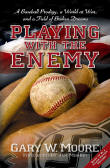 Playing
With the Enemy Playing
With the Enemy
Author: Gary W. Moore
The U-505 POWs are
sent to a remote camp in Louisiana. Not even the Red Cross is notified
of their existence. The Navy Baseball team are sent there as guards.
The U-505 men are not completely convinced that this “baseball” isn’t
a new interroga-tion
tactic. In the end, the spirit of competitive sports won out with “the
sound of men laughing and yelling in two languages” mixed with the
“crack of a wooden bat giving a hardball a ride through the humid
Louisiana morning air”.
|
|
 Back
from the Deep Back
from the Deep
Author:
Carl LaVO
On May 23, 1939, the
submarine U.S.S. Squalus sank while on a training exercise. A sister sub,
the Sculpin, located her and her survivors and stood by during the rescue.
The boat was raised and recommissioned as the Sailfish. Four and a half
years later, Sailfish sank the
Japanese carrier Chuyo, which, unbeknownst to the Americans, was carrying
survivors from the Sculpin, lost several days earlier.
|
|
 Castles
of Steel Castles
of Steel
Author:
Robert Massie
Castles of Steel is the newest book by Pulitzer Prize winning
historian Robert Massie. It is a history of the naval conflict between
Great Britain and Germany during the Great War, focusing on the major
surface actions of 1914, 1915, and 1916. It is an effortlessly-written
epic, voluminously detailed, and free of the sensationalism and
posturing that mars many modern history books. |
|
 Rise
to Victory Rise
to Victory
Author: R. Cameron Cooke
Nuke sub vs. littoral AIP sub, someone's bound to get hurt.
The US captain
meets his counterpart, Capt. Peto Triono of the Indonesian Navy.
Peto’s German-design Type 214 boat is a stark contrast to the US
nuclear sub. Diesel powered with AIP (Air Independent Propulsion,
i.e., fuel cells power the electric motors) capabilities—it can cruise
silently at 8 knots for 17 days without surfacing or snorkeling.
|
|
 Operation Drumbeat Operation Drumbeat
Author: Michael Gannon
U-123, commanded by Kapitänleutnant Reinhard Hardegen, serves as
the focal point for Gannon’s narrative. In his two Drumbeat patrols,
Hardegen sank 19 merchant ships, one of them barely 20 miles from New York
City. Gannon recalls 123’s near-sinking at the hands of a Norwegian
factory ship, it’s encounter with the Q-Ship Atik, and the infamous
torpedoing and shelling of the tanker Gulf America. |
|
 The
U-Boat War The
U-Boat War
Author: David Westwood
The U-boat War skillfully chronicles the
logistical issues and technological gains that worked for and against
the U-boats. This studied analysis of the tactics, planning,
technology, and logistics sheds light on why the war was lost and what
events contributed to the defeat of the German U-boat arm. |
|
 Rig
Ship for Ultra Quiet Rig
Ship for Ultra Quiet
Author: Andrew Karam, Ph.D
With a host of Soviet ASW planes, helos,
and ships on high alert combing the area looking for American subs,
searching diligently for Plunger... she obliges them by
deliberating taking the bait and sneaking into their midst, working up
fire-control solutions and taking photographs. |
|
 Hunt
and Kill: U-505 and the U-boat War in the Atlantic Hunt
and Kill: U-505 and the U-boat War in the Atlantic
Author: Theodore P. Savas, ed.
U-505 was the first enemy warship captured by the United States
since the War of 1812. Much has been written about how Captain Daniel
V. Gallery conceived of and successfully executed the plan that
resulted in the capture of U-505. Hunt and Kill, from
publisher Savas Beatie, is the first book to describe the complete
history of U-505, from its commissioning as a warship in 1941
to its current status as an exhibit in Chicago’s Museum of Science and
Industry. |
 Red
Star Under the Baltic: Red
Star Under the Baltic:
A First-Hand Account of the Life on
Board a Soviet Submarine in WWII
Author:
Victor Korzh
"Red Star" was written in the early
1960s, when the events portrayed were still reasonably fresh in the
author's mind, and originally published in Russian in 1966 under the
title "Reserve of Strength." Presented in the first person, Korzh's
superb record details the abysmal life and death conditions Soviet
sailors endured on their primitive but stoutly constructed boats.
|
 U-Boat
Killer U-Boat
Killer
Author: Capt. Donald
MacIntyre
McIntyre established himself as one of the greats. He captured the
number one German U-boat ace Otto Kretschmer (whose Zeiss binoculars he took and used
for the rest of the war); in the same battle, he directed the attack that
killed the second-scoring ace Joachim Schepke. Later in the war, his ship
was torpedoed; before that he nursed a bent-nosed destroyer back to
port after ramming a U-boat.
|
 Voyage
of the Gray Wolves Voyage
of the Gray Wolves
Author: Steven
Wilson
Famed U-boat commander
Kapitänleutnant Guenter "the Silent" Kern is called on by
Admiral Doenitz to undertake a mission so vital to the
Reich’s survival that he is allocated a small flotilla of 15
Type XXI U-boats. |
 Steel
Boat, Iron Hearts: Steel
Boat, Iron Hearts:
A U-boat Crewman’s Life Aboard U-505
Author: Hans
Goebeler with John Vanzo
Written with the
capable assistance of writer
John Vanzo, this book is notable because it is provides
a non-officer’s perspective. Goebeler dutifully kept
diaries, notes, mementos, and reminders of his service
aboard U-505, which, along with subsequent research and a
copy of the ship's log, served as the core for this book. |
| |
Read a
good sub or naval book lately? Interested in posting a
review here?
Sign up here as a Subsim.com Book Reviewer |
U-BOATS AND WOLFPACKS
More U-Boats and Wolfpacks
MASTER AND COMMANDER
NUCLEAR SUBMARINES
U.S. WWII FLEET BOATS
Still looking for more? Search the entire
catalog--1500 titles.
|

SUBSIM® Review
© 1995-2023 SUBSIM® Review
"Subsim" is a registered trademark. All rights reserved.
Legal Notice
| Privacy
Policy
submarine, game, submarine game, wolfpack, u-boat, simulation, subsim, sim
| | |

